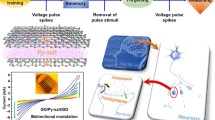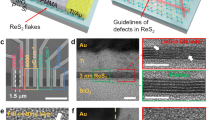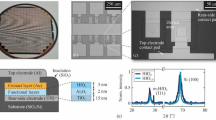Abstract
The emerging two-terminal memristor with a conductance-adjustable function under external stimulation is considered a strong candidate for use in artificial memory and electronic synapses. However, the stability, uniformity, and power consumption of memristors are still challenging in neuromorphic computing. Here an Au/SnSe/graphene/SiO2/Si memristor was fabricated, incorporating two-dimensional graphene with high thermal conductivity. The device not only exhibits excellent electrical characteristics (e.g., high stability, good uniformity and a high ROFF/RON ratio), but also can implement biological synaptic functions such as paired-pulse facilitation, short-term plasticity and long-term plasticity. Its set and reset power values can be as low as 16.7 and 2.3 nW, respectively. Meanwhile, the resistance switching mechanism for the device, which might be associated with the formation and rupture of a filamentary conducting path consisting of Sn vacancies, was confirmed by high-resolution transmission electron microscopy observations. The proposed device is an excellent candidate for use in high-density storage and low-power neuromorphic computing applications.
摘要
在外部刺激下具有电导可调功能的新兴两端忆阻器被认为在记忆和电子突触功能方面颇具潜力. 但是, 目前忆阻器的稳定性、 均匀性和功耗在神经形态计算中仍然具有一定挑战性. 本文中, 我们利用具有高导热性的层状二维石墨烯制造了Au/SnSe/石墨烯/SiO2/Si忆阻器. 该器件不仅具有压倒性的电性能(高稳定性、 均匀性和ROFF/RON比), 而且还可以实现生物突触功能, 例如双脉冲促进、 短期可塑性和长期可塑性. 其开关功率值分别可降低至16.7 和2.3 nW. 同时, 高分辨透射电子显微镜图证实了该器件的电阻转换机制, 可能归因于由锡空位组成的丝状导电路径的形成和破裂. 该设备有望应用于高密度存储和低功率神经形态计算领域.
Similar content being viewed by others
References
Wang Z, Joshi S, Savel’ev SE, et al. Memristors with diffusive dynamics as synaptic emulators for neuromorphic computing. Nat Mater, 2017, 16: 101–108
Jo SH, Chang T, Ebong I, et al. Nanoscale memristor device as synapse in neuromorphic systems. Nano Lett, 2010, 10: 1297–1301
Wang ZQ, Xu HY, Li XH, et al. Synaptic learning and memory functions achieved using oxygen ion migration/diffusion in an amorphous InGaZnO memristor. Adv Funct Mater, 2012, 22: 2759–2765
Prezioso M, Merrikh-Bayat F, Hoskins BD, et al. Training and operation of an integrated neuromorphic network based on metal-oxide memristors. Nature, 2015, 521: 61–64
Yan X, Zhao Q, Chen AP, et al. Vacancy-induced synaptic behavior in 2D WS2 nanosheet-based memristor for low-power neuromorphic computing. Small, 2019, 15: 1901423
Kim MK, Lee JS. Short-term plasticity and long-term potentiation in artificial biosynapses with diffusive dynamics. ACS Nano, 2018, 12: 1680–1687
Novoselov KS, Geim AK, Morozov SV, et al. Electric field effect in atomically thin carbon films. Science, 2004, 306: 666–669
Novoselov KS, Geim AK, Morozov SV, et al. Two-dimensional gas of massless Dirac fermions in graphene. Nature, 2005, 438: 197–200
Jariwala D, Marks TJ, Hersam MC. Mixed-dimensional van der Waals heterostructures. Nat Mater, 2017, 16: 170–181
Chen CL, Wang H, Chen YY, et al. Thermoelectric properties of p-type polycrystalline SnSe doped with Ag. J Mater Chem A, 2014, 2: 11171–11176
Wang H, Ren D, Lu C, et al. Investigation of multilayer WS2 flakes as charge trapping stack layers in non-volatile memories. Appl Phys Lett, 2018, 112: 231903
Luo S, Qi X, Yao H, et al. Temperature-dependent Raman responses of the vapor-deposited tin selenide ultrathin flakes. J Phys Chem C, 2017, 121: 4674–4679
Ye Y, Xian Y, Cai J, et al. Linear and nonlinear optical properties of few-layer exfoliated SnSe nanosheets. Adv Opt Mater, 2019, 7: 1800579
Ni ZH, Wang HM, Ma Y, et al. Tunable stress and controlled thickness modification in graphene by annealing. ACS Nano, 2008, 2: 1033–1039
Ghosh S, Bao W, Nika DL, et al. Dimensional crossover of thermal transport in few-layer graphene. Nat Mater, 2010, 9: 555–558
Wang J, Zhu L, Chen J, et al. Suppressing thermal conductivity of suspended tri-layer graphene by gold deposition. Adv Mater, 2013, 25: 6884–6888
Zhou Z, Zhao J, Chen AP, et al. Designing carbon conductive filament memristor devices for memory and electronic synapse applications. Mater Horiz, 2020, 7: 1106–1114
Choi S, Tan SH, Li Z, et al. SiGe epitaxial memory for neuromorphic computing with reproducible high performance based on engineered dislocations. Nat Mater, 2018, 17: 335–340
Sun H, Liu Q, Li C, et al. Direct observation of conversion between threshold switching and memory switching induced by conductive filament morphology. Adv Funct Mater, 2014, 24: 5679–5686
Chen C, Yang YC, Zeng F, et al. Bipolar resistive switching in Cu/ AlN/Pt nonvolatile memory device. Appl Phys Lett, 2010, 97: 083502
Chae BG, Seol JB, Song JH, et al. Nanometer-scale phase transformation determines threshold and memory switching mechanism. Adv Mater, 2017, 29: 1701752
Liu D, Cheng H, Zhu X, et al. Analog memristors based on thickening/thinning of Ag nanofilaments in amorphous manganite thin films. ACS Appl Mater Interfaces, 2013, 5: 11258–11264
Chen C, Gao S, Tang G, et al. Effect of electrode materials on AlN-based bipolar and complementary resistive switching. ACS Appl Mater Interfaces, 2013, 5: 1793–1799
Li Y, Xu L, Zhong YP, et al. Associative learning with temporal contiguity in a memristive circuit for large-scale neuromorphic networks. Adv Electron Mater, 2015, 1: 1500125
Hanna MJ, Zhao H, Lee JC. Poole Frenkel current and Schottky emission in SiN gate dielectric in AlGaN/GaN metal insulator semiconductor heterostructure field effect transistors. Appl Phys Lett, 2012, 101: 153504
Houng MP, Wang YH, Chang WJ. Current transport mechanism in trapped oxides: A generalized trap-assisted tunneling model. J Appl Phys, 1999, 86: 1488–1491
Burns ME, Augustine GJ. Synaptic structure and function: Dynamic organization yields architectural precision. Cell, 1995, 83: 187–194
Acknowledgements
This work was financially supported by the National Natural Science Foundation of China (51972094, 61674050 and 61874158), the Outstanding Youth Project of Hebei Province (F2016201220), the Project of Science and Technology Activities for Overseas Researcher (CL201602), the Project of Distinguished Youth of Hebei Province (A2018201231), the Support Program for the Top Young Talents of Hebei Province (70280011807), and the Supporting Plan for 100 Excellent Innovative Talents in Colleges and Universities of Hebei Province (SLRC2019018).
Author information
Authors and Affiliations
Contributions
Author contributions Yan X designed the samples and revised the paper. Wang H conducted the performance test of the device and prepared the manuscript. Yu T analyzed the data. Zhao J assisted in writing the response. All authors contributed to the general discussion of the manuscript.
Corresponding authors
Ethics declarations
Conflict of interest The authors declare no conflict of interest.
Additional information
Hong Wang received her MSc degree from Hebei University in 2018. She is currently pursuing a PhD degree at the Department of Physics, Hebei University. Her research interests include the design and application of 2D-material-based devices.
Tianqi Yu received his Bachelor’s degree from Henan University of Science and Technology in 2018. He is a graduate student at the College of Electronic and Information Engineering, Hebei University. His current research focuses on memristors.
Shufang Wang received her PhD degree in optics from the Institute of Physics, Chinese Academy of Sciences in 2004. She then joined the group of Professor D. Rémiens at IEMN-CNRS, France and the group of Professor Xiaoxing Xi at Pennsylvania State University as a postdoctoral fellow. Her research focuses on photoelectric/ thermalelectric materials and devices.
Xiaobing Yan received his PhD degree from Nanjing University in 2011. He is currently a professor at the College of Electron Information and Engineering, Hebei University. His current research interests include the study of emerging memories, such as charge-trapping memory, phase-change memory, resistive switching memory, and brain-inspired neuromorphic devices.
Supplementary Information
Rights and permissions
About this article
Cite this article
Wang, H., Yu, T., Zhao, J. et al. Low-power memristors based on layered 2D SnSe/graphene materials. Sci. China Mater. 64, 1989–1996 (2021). https://doi.org/10.1007/s40843-020-1586-x
Received:
Accepted:
Published:
Issue Date:
DOI: https://doi.org/10.1007/s40843-020-1586-x




